By Alexandra Deselms, Interim Director & Director of Collections
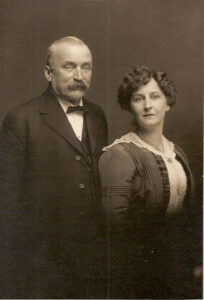
Angus and Anna McDonald, Meeteetse Museum Collection 88.26.11
Angus James McDonald pursued a variety of careers and work during his life, and because of this, he was one of the foremost early citizens of Meeteetse.
Angus McDonald was born in June 1853 in Cornwall, Ontario, Canada to Alexander Angus McDonald and Flora Fraser as one of eleven children. The family was of Scotch descent, a source of pride to him throughout his life. He came to the US in 1874 and spent the winter in Michigan, according to a memoir in the collections.
He traveled by Union Pacific Railroad and then stage to South Pass, Wyoming and Fort Washakie (then Camp Brown), where he met his older brother Donald (Dan) and began work on the Ox Train for the government:
The outfit consisted of 4 teams of oxen of 8 yoke each. The crew, 4 drivers and 1 wagon boss (Dan). We hauled corn and oats for the calvary horses and commissary supplies for the soldiers. / I walked back and forth behind those 4 teams seeing that each did his share. Made 6 trips one summer – 300 miles round trip. The other 4 years – 5 trips each summer, making 6000 miles, besides all the other walking required in catching the 16 head out of the 64. I have not been able to walk much since.
He traveled throughout the Bighorn Basin with this outfit. “There was no white people from Landor [sic] north to the Montana line. I killed buffalo, deer, elk and antelope, wolves, coyotes, bobcats and bears. After one of my favorite horses was bitten by a rattler, I started in on them but gave it up after killing 150.” Although traveling, Angus, like several of the pioneer men who would end up in Meeteetse, quickly heard about the outcome of the Battle of the Little Bighorn. “At the time of the Custer Battle, I was on the road between Bryan and Old Camp Brown (now Fort Washakie) and got in a camp in time to hear the news of the massacre, which had just reached there.”
He interacted with and knew several of the influential Native Americans in the area. “Of the Indians I knew very well, Washakie was my favorite. He was chief of the Shoshonies [sic]…Washakie was a good and sensible Indian….Black Coal, Little Wolf and Friday often came to my camp. Friday liked to talk and could speak very good English.” A story in the Basin Register says that “Black Coal, chief of the Arapahoes, always called McDonald brother, because both of them had the same two fingers missing from the left hand.”
Coming through the Bighorn Basin when he did, Angus left his mark on the map by naming one of the smaller basins. “As far as I know, I was the first white man in the Buffalo Basin Country. My saddle horses used to get loose and go over there, and as I always saw buffalo there, I called it Buffalo Basin.”
Sleeping outside in all weather, he particularly remembered how well the buffalo hides worked for the Native Americans he saw. “A young Indian rode up and threw his buffalo hide…on the ground [one night in 1889 when it was 40 below 0]. He pulled his blanket over him and settled down for the night. I went to him in the morning and gave him a shake. I expected to find him stiff but he jumped up lively as a rabbit and away he went.”
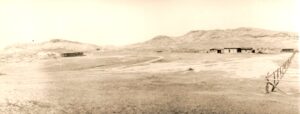
McDonald Ranch, Dickie WY 1898
Angus claims that he sold his outfit and bought 200 head of cattle to begin homesteading on the Gooseberry in 1880 under the Quarter Circle Y brand, although the 1880 census lists him in Sweetwater County, WY as a quartz miner. Angus ran P.P. Dickerson’s cattle along with his own. “After the first few years used to round up over nearly all of the Big Horn Basin, about ten thousand square miles.” He went into partnership with Dick (PP) in 1885.
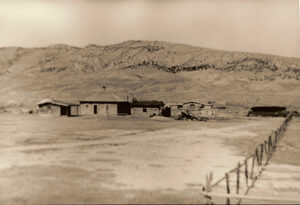
McDonald Ranch, Dickie, WY 1898 Gooseberry Creek
After the bad winter of 1886-87, he lost 60% of his cattle and in 1895, he sold them to Otto Franc and went to California to grow oranges and lemons. The citrus trees froze within two weeks and so did the walnuts so Angus returned to cow punching. He went first to Idaho, where he bought 600 steers and brought them to Wyoming with the help of a crew of Mormons. A year later when he sold the cattle, he almost made back what he lost on the orange grove. He then sold his ranch to David Dickey, who operated the LU Sheep Company.
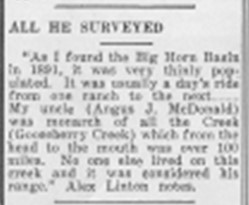
Meeteetse Times Supplement to Cody Times published September 1, 1949 on page 5.
Angus believed that:
“The stock industry in Wyoming was delayed on account of it not being generally known that stock could winter here, which was found out by an accident. Some oxen having wandered from a party of immigrants and given up as lost, were found fat and in excellent condition the following spring. Before that, there was little of Wyoming except where the railroad or immigrant passed through.”
He enjoyed his down time with the cowboys in Lander in the mid-1880s.
The first dance I went to was in Landor [sic]…This is the cowboy quadrille call – ‘PARTNERS FOR QUADRILLE.’ ‘This is the man who killed the sheep, This is the man who drank his blood’ etc….cowboys used to gather in Landor [sic] in the winter time. Had great times – sometimes 40 of them would all be singing the only song they all knew and there was 99 verses of it just alike, ‘The bear came over the mountain, the bear came over the mountain to see what he could see.’
In 1899, he started the Meeteetse Mercantile Company under his own name and also kept the Post Office; the next year he had a telephone line put in from Red Lodge, Montana. He sold the store in 1902, but when the new firm went bankrupt in less than a year, he reorganized it and made his nephew Alex Linton the manager.
As one of the early postmasters, he was able to give detailed accounts of what early mail service into Meeteetse looked like.
The mail was supplied from Fort Washakie, 250 miles from Rail Road on the Shoshonie [sic] Indian Reservation, by pack horses once a week, (100 mile trip, 3 days each way)….We began to get mail from Billings after the Northern Pacific Built in, in 1884. The mail came to Meeteetse once a week, 160 miles, by buckboard. In 1896, we began to get mail from Billings and Fort Washakie after A.C. Thomas plotted Meeteetse and the post office was moved here. Also in 1896, we began to get mail from Red Lodge.
In 1900, he started a bank with W.T. Hogg and Harris E Cheeseman, personally furnishing the capital to get it started. In July 1902, they changed the name to the First National Bank of Meeteetse (now the First National Bank Museum). “I took charge of the bank, and up to now they haven’t been able to get rid of me there. I worked in the bank two years for $40.00 per month, boarding myself.”
He served as a member and organizer of the board of Commissioners for both Big Horn and Fremont Counties. He served in the lower house of the state legislature in 1899 and as mayor of Meeteetse several times “and first aid in case of duels and undertaker when necessary.”
When the first schools were started in the area, Angus served as the treasurer of the Meeteetse school in 1886. Apparently, there were lax school laws that led to an unusual event. As treasurer, all the money for the school year was sent to Angus. Pioneer Tom Osborne said in his memoirs that “When [Fred] Whitney found out that McDonald was leaving for Canada, Whitney wrote out a warrant for Sleeper’s wages. McDonald ran short of money on his trip and used the school money, making Doc Sleeper [the teacher] wait for his wages until McDonald shipped his cattle the next fall.” This first teacher at the school in Meeteetse was W.B. Sleeper of the Sleeper Ranch. Plenty of money was “appropriated” for the school, and then only one student came and just for a few days. “But those few days teaching were all right, as the student made good and is one of our local capitalists, he made a good student later.”
As with most pioneers, Angus had hunting stories from his time ranching, particularly of bison and bears.
“You want to hear a bear story? Who’d be so foolish as to want to hear of killing buffaloes or bears? Oh well, if I must, here is one in short order. Although I went on Buffalo hunts for many years, I killed this one from my cabin door. I heard him bellowing as he came along Ennis Creek, and when he came in sight I shot him. NO, I WON’T TELL A HORSE BACK ONE. Oh well, I saw one coming down the trail, and as I was on my little blue pony, I rode down the bank out of sight. I waited until he came close, and not having a gun, just a six shooter, when he was close I rode up on the bank in sight. He went the other way. I rode up close and shot him. He went about ten feet and dropped.
One evening I was alone at the ranch, when the deputy sheriff, Cicero Avant, came along and stayed all night, as he was on his way to Landor [sic]. Next morning he started off and got about 200 yards from the house, when he saw some bear tracks in the trail. He came back and wanted me to go with him to hunt those bears. I looked at my cartrdges [sic] and told him that I only had five for my Winchester. He said that was enough, we would go anyway. He had a little 32 pistol, about as much good as a pop gun. I saddled up and we started off about eight o’clock. It was a beautiful September morning. We trailed those bears for miles and miles up Middle Creek. They followed the creek two or three miles and turned off up a gulch. We trailed them up and finally came to where the gulch forked, so we seperated [sic] and one went up each ridge.
I went up to the right of a big rock. The bears were under a shelf of rock and when Mr. Avant came up the old bear rushed at him. I shot her and she tumbled out of sight. I thought she was only wounded and I wanted to save my cartridges for her. In a second out came another, right towards me. I side stepped. Out came another, which passed on. Then a third came. I shouted to Mr. Avant, asking where the old bear was. He said she was dead and I had been saving my ammunitinn [sic] for her, as they were silver tips, and there wasn’t a tree in half a mile. I shot 2 others, which were very big young bears.
Afterwards I heard of “W” who is a lord in the old country telling how I killed “four bears with three cartridges”.
After his ranching adventures, Angus settled in town with the Mercantile and later the Bank. The 1900 census showed him living in Meeteetse as the merchant at the general store, age 45 , single, and owning his own home. His immigration year was listed as 1874 but he was not a naturalized citizen.
By the 1910 census, Angus had become a banker and had two nieces living with him. Anna McIntosh and her sister, Florence Mary Catherine McIntosh, were the daughters of Angus’s older sister, Flora McDonald McIntosh. Anna immigrated from Canada in 1905 and was about 30 at the time of the census. Florence was 25 and had immigrated in 1907; she listed her occupation as Assistant Cashier at the bank. It seems Anna never married and died in 1930, being buried in Canada near her parents and a couple siblings apparently. Florence went on to marry James Leo Price in Billings, Montana in November 1910; the couple lived in Meeteetse and had six children. They moved to Missoula, Montana between 1917 and 1920 and she lived there until her death in 1952. As Angus’s nieces were born right before or right after Angus immigrated (although he likely visited at least once per the teacher salary story), it is interesting that they ended up living with him for a period. As of this time, we have not found any records on how or why they were in Meeteetse with him.
In 1912, Angus became a member of the Pioneer and Historical Society of Meeteetse.
In November 1914, Angus married Anna A. French in Springfield, Missouri at St. Joseph’s Church. Her parents Michael and Nora French were witnesses. Anna was born in Missouri about 1877, but we don’t know much more about her early life or how the couple met. As he came east to Missouri to marry her, she is not exactly a “mail order bride.” Anna was about 37 and Angus was 61 when they married.
In March 1916, Angus and Anna’s first child, Angus James McDonald (Junior) was born in Los Angeles, California. By July 1917, they were in Billings, Montana, where their second child, Alexander French McDonald, was born.
In November 1919, Angus entered into an agreement with L.G. Phelps and Charles Belden to share in the investments of sheep and feed in The Grey Bull Corporation along with W.R. Coe and Fred. A. Whitney (and the Sayles Sheep Company). Within three years, the agreement stated, Angus could return the agreement and receive his money ($16,000) back; if more earnings were received, those would also be paid. The $16,000 paid for the purchase of 1000 sheep. As part of the agreement, Angus would “sell to the Corporation all the hay and grain raised on his ranches on the Grey Bull River above the Whitney Ranch; the Corporation to have the use of the ranches for the wintering of any live stock [sic].” The buy-in Angus paid bought sheep for the enterprise. “The Grey Bull Corporation acknowledges the receipt of sixteen thousand dollars ($16,000.00) with which the one thousand sheep were pirchased [sic]. The Corporation also accepts the obligation to purchase all hay and grain raised on the McDonald ranches” signed LG Phelps, President, and Charles J Belden, Secretary. After this agreement, in 1920, Angus took out a permit for $70 from the Forest Service to graze 1000 sheep in the Shoshone National Forest and bought a brand from LG Phelps.
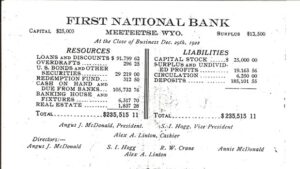
Ending balance of 1922 at the First National Bank.
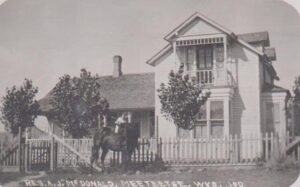
Residence of AJ McDonald
After the family’s travels and during this time arranging the new venture, they returned to Meeteetse. Indeed, the 1920 census listed Angus as a banker again and his wife Annie and sons Angus J (age 3) and Alexander F (age 2) with him in Meeteetse.
According to a memoir by B. Baker (child of newspaper publisher William H Baker, whose family came to Meeteetse in 1912), the print shop building near the Mercantile also had a saloon. Angus’s source of pride in his Scottish heritage led to his saloon (likely the one at the print shop near the Mercantile) being used as the headquarters for the local Scotsmen. “Some of them owned sheep and others less fortunate were the herders. All had one thing in common. They had a fondness for whiskey and the town invariably came to life Saturday nights; even more so on Caledonia Day when bagpipers led the celebrants in a continuous round from one saloon to another. This was one night when few townspeople slept soundly.”
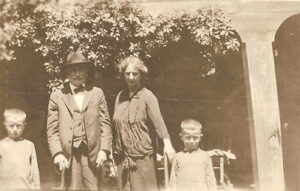
Photo of Mr. and Mrs. McDonald with their two boys, who appear to be about 5 and 3. Meeteetse Museum Collections 88.26.16
Angus died on September 13, 1923 at the age of 71 from mitral stenosis, a narrowing of the heart value whose main cause is rheumatic fever (related to strep throat and scarlet fever). His death left his wife a widow at about age 46 and their sons without a father at the young ages of seven and six.
A solicitor who knew him in Canada wrote to Anna that “You will recall that when you and he and your boys were here this summer that Doctor D.O. Alguire of this Town, whom Angus had consulted, reported that his condition was precarious. / He was of the race of pioneers who really built the State of Wyoming, and as time passes on his services and achievements will loom in greater prominence and more out-standing out-lines.”
At some point after Angus’s death, Anna moved up to Missoula, Montana for the children to attend school. She moved back to Meeteetse with Angus Jr by 1940. She died in October 1956 in Washington, possibly on a trip to visit her son Alexander. She is buried in Missoula at St. Mary’s cemetery. Anna was very active in the Catholic church and was a member of the Little Flower Auxiliary of Discalced Carmelite Sisters of St. Louis Missouri as well as the Catholic Union. We have several of her (as well as her sons’) items in the museum’s collection.
After graduating high school in 1932, Angus Jr received a philosophy degree from Gonzaga University and an engineering degree from the University of Wyoming. He served in the army in the Pacific in World War II; he worked at the Meeteetse Bank and then for the Phillips Petroleum Company in Texas and Oklahoma. He married Marilee Margaret Jennings in Texas in September 1956. He died in November 1978 in Oklahoma and was buried in Missoula.
Alexander studied at Gonzaga University and the University of Detroit. He went into the priesthood and was ordained on June 16, 1947 in San Francisco, California. He led his first mass in Cody on July 6th, 1948. He died in May 2010 in Washington and is buried at the Jesuit cemetery in Spokane, Washington.
Upon Angus’s death, the Basin Register printed that “In all his years in Wyoming, Angus McDonald was recognized as the kind of man that does things and he was of great help to many neighbors and friends, whom he helped over the rough places of life. / The country is the beter [sic] for his having lived and for the large part he played in its development.”
As a jack of all trades, Angus McDonald was an important pioneer in Meeteetse’s history.

